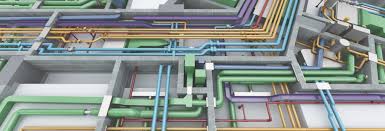In the dynamic landscape of construction, technological advancements continually reshape the industry’s practices, aiming for efficiency, precision, and sustainability. Building Information Modeling (BIM) stands at the forefront of this transformation, revolutionizing the way buildings and infrastructure are designed, constructed, and managed. In this blog, we delve into the manifold benefits of BIM Implementation Services, exploring how it streamlines construction processes and enhances project outcomes.
Understanding BIM
BIM is not merely a software or tool; it represents a paradigm shift in the approach to construction projects. At its core, BIM is a digital representation of physical and functional characteristics of places. It goes beyond 3D modeling by incorporating additional dimensions such as time (4D) and cost (5D), along with other pertinent information. This comprehensive model serves as a shared knowledge resource for information about a facility, forming a reliable basis for decision-making throughout its lifecycle.
Enhanced Collaboration and Coordination
One of the most significant advantages of BIM lies in its ability to foster collaboration among various stakeholders involved in a construction project. Architects, engineers, contractors, and facility managers can work concurrently on the same model, facilitating seamless coordination and communication. This integrated approach minimizes errors, reduces conflicts, and ensures that all parties are aligned with the project’s objectives. With real-time access to a centralized database, teams can make informed decisions promptly, thereby accelerating the construction timeline.
Improved Design Efficiency
BIM enables architects and designers to create highly detailed and accurate digital representations of structures. By visualizing the entire project in a virtual environment, they can identify potential issues early in the design phase and implement necessary modifications before construction begins. This proactive approach not only enhances design quality but also optimizes resource utilization and minimizes rework, leading to cost savings. Furthermore, BIM Implementation Services exploration of alternative design options, empowering stakeholders to make informed choices that align with project requirements and objectives.
Clash Detection and Risk Mitigation
Constructability issues and clashes between different building systems can significantly impede project progress and incur additional costs. BIM’s clash detection capabilities allow teams to identify and resolve conflicts virtually before they manifest on the construction site. By simulating various construction scenarios and analyzing potential clashes, stakeholders can proactively mitigate risks and ensure smoother project execution. This proactive risk management approach enhances safety, reduces costly delays, and fosters a more efficient construction process.
Accurate Cost Estimation and Budget Management
Cost overruns are a prevalent concern in construction projects, often stemming from inaccurate initial cost estimates and unforeseen changes during construction. BIM’s 5D capabilities integrate cost data with the digital model, enabling stakeholders to generate accurate cost estimates and track expenses throughout the project lifecycle. By linking design elements to cost data, BIM facilitates comprehensive budget management, allowing project teams to make informed decisions that align with financial constraints. This transparent approach enhances cost control, minimizes budget overruns, and improves overall project financial performance.
Enhanced Sustainability and Lifecycle Management
In an era increasingly focused on sustainability, BIM plays a pivotal role in promoting environmentally conscious design and construction practices. By analyzing factors such as energy consumption, material usage, and environmental impact within the digital model, stakeholders can make informed decisions to optimize sustainability performance. Additionally, BIM’s lifecycle management capabilities extend beyond construction, enabling efficient facility operation and maintenance. By integrating asset information into the model, facility managers can streamline maintenance workflows, optimize energy usage, and prolong the lifespan of built assets, thereby maximizing return on investment and reducing environmental footprint.
Streamlined Construction Operations
BIM Implementation Services revolutionizes construction operations by digitizing and optimizing various processes. From quantity takeoffs and procurement to scheduling and logistics planning, BIM facilitates greater efficiency and accuracy across the board. Automated workflows and data-driven decision-making enable project teams to streamline construction operations, minimize waste, and enhance productivity. By leveraging BIM for construction sequencing and progress tracking, stakeholders can monitor project milestones in real time, identify potential bottlenecks, and proactively address issues to ensure timely project delivery.
Regulatory Compliance and Documentation
Construction projects are subject to numerous regulatory requirements and documentation standards, which can be daunting to navigate without proper tools and systems in place. BIM serves as a central repository for project information, ensuring compliance with regulatory standards and facilitating documentation management. By incorporating relevant regulations and standards into the digital model, stakeholders can streamline compliance efforts and reduce the risk of costly violations. Additionally, BIM’s ability to generate detailed documentation, including as-built drawings and facility manuals, simplifies handover processes and enhances the transition from construction to facility management.
Conclusion
The implementation of BIM Implementation Services offers a multitude of benefits that revolutionize the construction industry. From enhanced collaboration and coordination to improved design efficiency, clash detection, and risk mitigation, BIM streamlines construction processes and enhances project outcomes. By leveraging BIM’s capabilities for accurate cost estimation, sustainability analysis, and streamlined operations, stakeholders can optimize project performance, minimize risks, and deliver projects more efficiently. As BIM continues to evolve and integrate with emerging technologies, its role in shaping the future of construction remains indispensable, driving innovation and transforming the built environment for generations to come.











